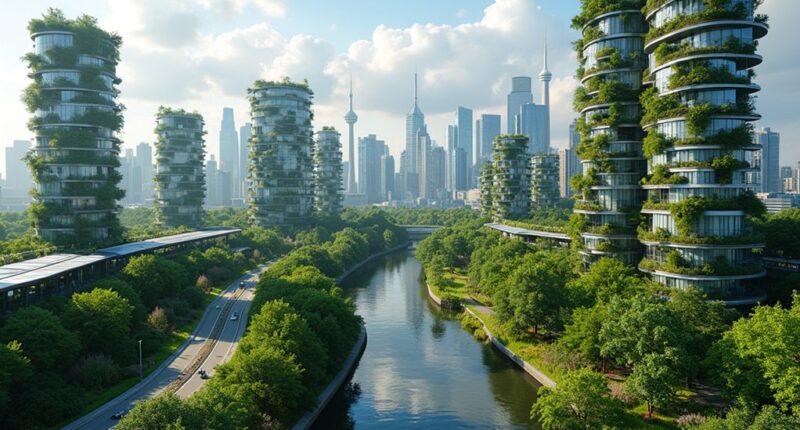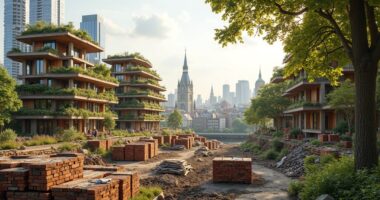In 2025, Canadian cities are transforming urban development with six exciting eco trends. Stricter energy efficiency standards are paving the way for buildings that won’t just sip energy but gulp it down wisely. The rise of deep green retrofits targets existing structures, aiming for big energy cuts and job creation. Smart technology is making cities smarter, adjusting building dynamics like an expert DJ. Curious about how these changes will shape our future? More exciting insights await!
Quick Overview
- Stricter energy efficiency standards aim for Net Zero Energy Ready homes by 2030, drastically reducing greenhouse gas emissions in urban developments.
- Adoption of deep green retrofits targets a 50% reduction in energy use, creating jobs and stimulating economic growth while enhancing energy efficiency.
- Smart building technology, leveraging IoT and AI, optimizes energy use and security, with the market expected to reach $150 billion by 2026.
- Climate resilience strategies employ real-time data to improve urban planning, ensuring cities thrive amid climate challenges and enhance building performance.
- Passive design and high-efficiency systems are increasingly incorporated into new constructions, maximizing natural light and ventilation for sustainable urban living.
Stricter Energy Efficiency Standards Transforming Building Practices
As Canadian cities gear up for a greener future, stricter energy efficiency standards are setting the stage for a construction revolution. The 2024-2025 regulations aim to slash greenhouse gas emissions, pushing builders toward Net Zero Energy Ready homes by 2030. Think of it as turning your drafty old house into a cozy, energy-efficient fortress. With enhanced requirements for insulation and air tightness, developers are adopting high-efficiency heat pumps and even smart technology—imagine your home adjusting the thermostat while you’re out! Passive design strategies that maximize natural lighting and ventilation are becoming central to modern construction projects. As compliance mechanisms tighten, those who cut corners risk being left out in the cold, literally and figuratively. To support this transformation, the enhanced compliance mechanisms ensure a smoother transition to energy-efficient buildings aligned with national climate goals. This aligns with the National Building Code updates that shift towards performance-based standards for energy efficiency.
The Rise of Deep Green Retrofits for Existing Structures
Deep green retrofits are becoming the rising star in the Canadian construction scene, and for good reason. These ambitious upgrades aim for a whopping 50% reduction in energy use, transforming tired old buildings into eco-friendly powerhouses. With only 29,000 out of 600,000 retrofits achieving deep status, there’s a goldmine of potential waiting to be tapped. Not only do these retrofits create around 75,000 jobs and save households significant cash, but they also slice greenhouse gas emissions like a hot knife through butter. As Canada looks toward a greener future, deep retrofits are leading the charge, turning yesterday’s structures into tomorrow’s sustainable marvels. The program’s success is evident, as it stimulated $11 billion in consumer spending and supported at least 75,000 jobs. Retrofitting older buildings reduces GHG emissions and enhances energy efficiency, making deep green retrofits a crucial strategy in combating climate change. These projects often incorporate sustainable materials that minimize environmental impact while maximizing building performance over its lifecycle.
Smart Building Technology and Climate Resilience in Urban Planning
In a world where technology and sustainability are increasingly intertwined, smart building technology offers a promising path toward climate resilience in urban planning.
These advanced structures employ IoT devices and AI to optimize energy use and enhance security, much like a personal trainer for your home. By 2026, the smart building market is projected to soar to $150 billion. Data-driven urban strategies enhance the effectiveness of these buildings by ensuring that real-time data is utilized for continuous improvement. Moreover, cities are already seeing real-time IoT data reshaping daily operations and enhancing energy efficiency.
Climate-responsive systems adjust automatically based on real-time data, ensuring efficiency. Digital twins, virtual replicas of cities, enable better planning. Environmental tracking through sampling methods provides crucial baseline measurements for monitoring pollution levels and assessing the effectiveness of green initiatives.
As urban leaders embrace smart tech, they’re crafting cities that not only survive climate challenges but thrive amid them. Who knew resilience could be this chic?









